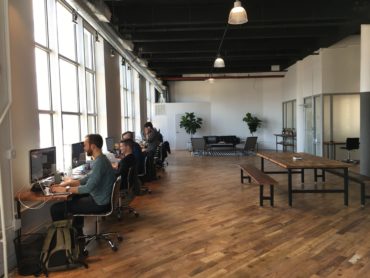
One of the many goals when leasing office space is to look for efficiencies in the space. Not that long ago offices were averaging 200-250 sf per worker. In 2017, North American offices will average 151 square feet per worker, according to real estate data provider CoreNet Global. Advancements in technology and a changing, more flexible workforce are making that it possible to achieve much higher levels of efficiency. As an example, we’ve listed three particular types of businesses below that are re-evaluate their space requirements. These types of companies can operate efficiently and with less space without sacrificing productivity or morale.
Sales Companies
Outside salespeople spend their productive, most effective working hours in the field meeting with clients and prospects – not at their desks. Tasks that used to be performed in the office such as updating paperwork and sending mail are now down remotely so you don’t need as large a space for your sales team. Further, clunky machines of the past have been replaced by more streamlined workstations when they are in the office.
Inside sales professionals do need office space but as mentioned above, the shrinking size of office technology reduces the size of workstations. In addition, many inside sales professionals choose to work remotely letting you get away with fewer workspaces. Inside reps can be productive with a laptop and a headset thanks to VOIP making the traditional desk phone obsolete. Centralized CRM systems also make paper-based recordkeeping unnecessary, letting you configure even smaller workstations.
Technology Companies
The trends that influence sales based companies also impact technology firms. As research continues to mount on the impacts of the open floor plan office (hint-good for some, not for others) employers are realizing that many workers who need intense concentration, like engineers and programmers, can actually be less productive in an open environment.
The solution to this problem is simple. Build more offices. Instead of building large offices that can accommodate teams you can create smaller rooms that are designed to let a single person get away from the distraction of an open office and get some quiet work done. These spaces can be available on an as-needed basis, letting you build fewer of them. They are also smaller than traditional offices, letting you save office space.
Companies with a High Percentage of Millennial Workers
Millennial workers are eager to bond with their co-workers and work collaboratively in open office spaces. Companies have embraced the open office design because it saves money. Open layouts maximize existing space while minimizing costs, particularly in an era when more employees are telecommuting and leaving cubicles empty. They also prefer to arrange their work around their lives, rather than the other way around. Because of this, they are likely to be open to remote working or work-live arrangements that shift some of your office space’s demands back to their own residence where they are paying the bills.
While the office space market remains in a state of flux, one trend is here to stay. Companies are doing more work than ever in less space. This leads to lower occupancy costs and a better bottom line.
